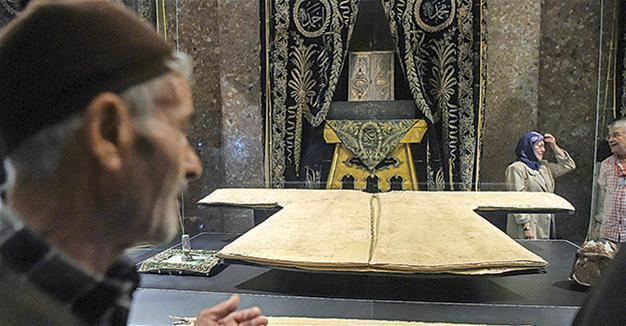Prophet’s cloak attracts Ramadan faithful in Istanbul
ISTANBUL - Agence France-Presse

AFP photo
The Prophet Muhammed’s sacred cloak made of linen, cotton and silk, a centuries-old garment pressed down flat inside a glass exhibition case in an Istanbul mosque, draws a long queue of men and women.The Hırka-ı Şerif (Noble Cloak) was brought to Istanbul in the 17th century, a time when the Ottoman Empire controlled much of the Islamic world deep in to what is now known as Saudi Arabia.
Every year, during the holy Muslim fasting month of Ramadan, the cloak is put on special display at the Hırka-ı Şerif mosque, attracting hundreds of thousands of visitors.
“I was here last year. God willing, I will be here next year as long as I am alive,” 78-year-old Nimet Şahin said, as caretakers warned visitors selfies were inappropriate. Neziha Polat, 76, said she felt as if she was in Mecca, the holy Islamic city to which all Muslims are required to make a pilgrimage in their lifetimes.
“I come here every year and have the same feeling. Let God not diminish this feeling in our heart,” she said in tears.
The garment had been entrusted to Uwais al-Qarni, who went to Medina to see Prophet Muhammed during the seventh century but had to return to Yemen due to his mother’s illness without seeing the Prophet.
Impressed by the story, Muhammed presented his cloak to al-Qarni via companions and he received the garment in Yemen.
Al-Qarni had no children and the relic was then preserved by his relatives, Istanbul mufti Hasan Kamil Yılmaz said.
In 1611, Ottoman Sultan Ahmed I brought the holy cloak to Istanbul from Kuşadası in western Turkey where al-Qarni’s relatives had preserved it. “Since then, Hırka-ı Şerif has been in Istanbul,” Yılmaz said.
In 1851, Sultan Abdul Majid built the Hırka-ı Şerif mosque in the Fatih district with the goal of preserving and exhibiting the cloak.
“There are two keys to the cloak – one held by the foundation and the other by the family,” he said.
The sacred garment has been passed on from one generation to another and its current head keeper is Barış Samir, the 59th generation grandson of the al-Qarni who was first given the garment.
“It’s a very honorable duty. We are very happy to uphold it and have such a responsibility,” Samir said.
“It’s also a tough job, it is a tough responsibility, morally and financially.” An old man, wearing an Islamic skullcap and waiting his turn in the queue to see the garment, said he was at peace.
“What can be more precious than this in life?” he asked. “I have seen this before I die.”
Zehra, 48, said it was great happiness for Muslims to even lay eyes on the Prophet’s cloak. “I believe it brings us closer to him.”
Every year, over one million believers come to see the sacred garment from all over the world. “People from Siberia to Africa, from America to the Far East come and see the Prophet’s cloak. The number of visitors usually exceeds one million. We receive many visitors especially on the Laylat al-Qadr (Night of Destiny, marking when the Quran was revealed) because the cloak can be seen until the morning,” Samir said.
Loukman Hakim, 49, a businessman from Malaysia, was among the visitors along with a group of around 20 Malaysians.
“Of course it makes us closer to Prophet Muhammed. It makes us happy, it makes us feel that we have to do something in order to be with him, meaning to say that we have to spread the love, spread the teaching, and spread all the goodness that Prophet Muhammed has brought to mankind,” Hakim said.
Samir said the cloak’s display was a meeting point between the Prophet and the believers: “We are happy to bring them together.”
















